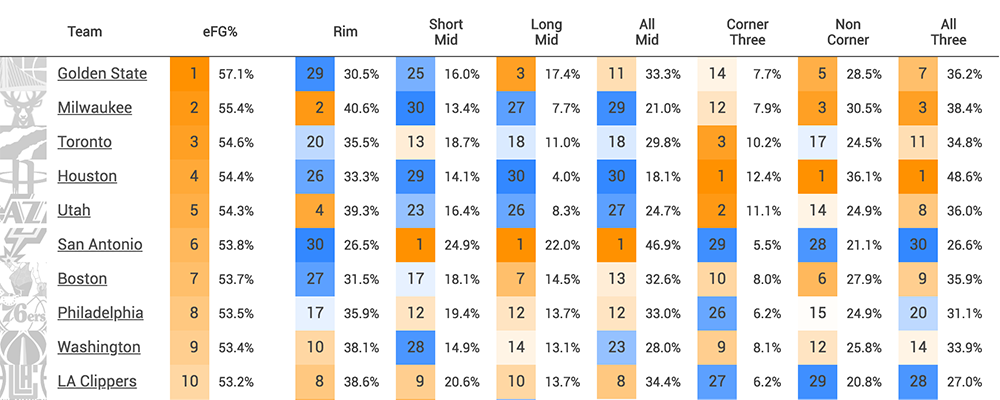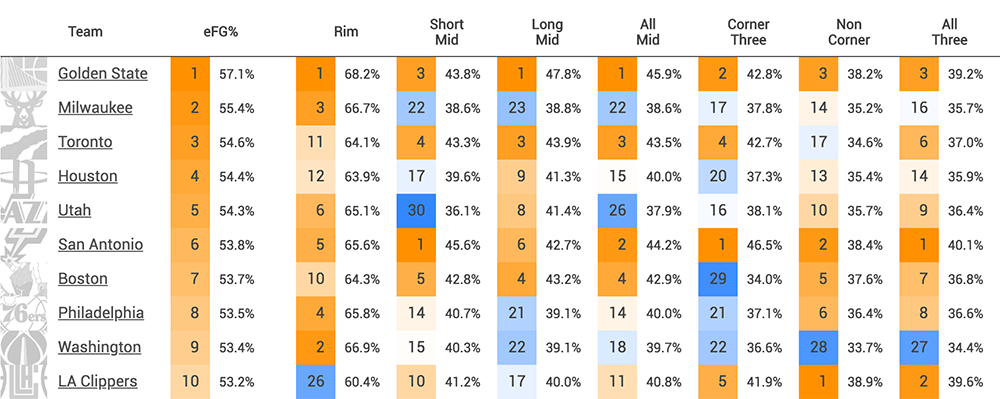League: Shooting
The League Shooting table takes you a level deeper than the Four Factors Summary. This table also gives a sense of a team's offensive and defensive style, but does so by breaking down where they shoot from and how well they shoot in those spots.
Location Definitionsclick to show/hide
This data is based on shot locations from play-by-play. This data can be especially messy and therefore is not exact — it depends on where the scorer marks the shot as the game is happening, which can be inexact or even sometimes way off. There are also issues with different scorers marking shots differently. For example, on a layup, some scorers mark where the player took off from and some scorers mark it where the shot was released (at the rim).
That said, these stats are generally pretty good and, over large samples, can tell us a lot about how a player plays. The official definitions are below, but here is a quick overview of how to think about these different types of locations:
- Rim: layups, dunks, and tip shots.
- Short midrange: usually runners and floaters off the drive, or hooks or fadeaways from the post.
- Long midrange: for guards and wings these are likely to be pull-ups off the dribble, for big men these are likely to be spot up or pick-and-pop jumpers.
- All midrange: the previous two categories combined.
- Corner threes: threes taken below the break in the arc, where the threes are a shorter distance than other three point attempts.
- Non-corner threes: threes taken above the break in the arc, removing heaves (estimated from play-by-play based on distance and time left on the shot/game clocks).
- All threes: the prevous two categories combined.
Note that for years in which we have shot locations for shooting fouls drawn (starting in the 2010-11 season), shooting fouls are included for determining where teams are shooting from.
Let's break down why these teams ended up being the best shooting teams in the league (measured by eFG%, which you can read more about in the League Four Factors guide). First, we can look at where these teams attempted their shots by looking at the "Frequency" section.
Example: 2018-19 Top 10 Shooting Teams

What jumps up is just how much orange there is in the three point section and how much dark blue in the midrange section. That tells us the best teams took few midrange shots and a lot of threes. Meanwhile, most of the best offensive teams didn't get to the rim at a very high rate, which is a surprise. Of the top 7 shooting teams by eFG%, 5 of them were ranked 20th or worse in getting to the rim.
That doesn't mean the rim is unimportant, though, which becomes clear when we move to the shooting accuracy section:

All of the top 9 shooting teams ranked in the top 12 in FG% at the rim. Almost all of these teams shot well from three and from long midrange. They used outside shooting to create good looks at the rim, and that's how they achieved their efficiency.
The Gritty Details
- Rim: shots taken within 4 feet of the basket.
- Short midrange: the distance of a foul shot and closer. Inside of 13.75 feet from the rim but outside of 4 feet.
- Long midrange: two point shots taken outside of 13.75 feet.

